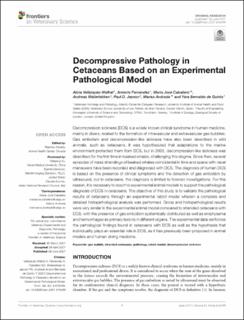| dc.contributor.author | Velázquez-Wallraf, Alicia | |
| dc.contributor.author | Fernández, Antonio | |
| dc.contributor.author | Caballero, María José | |
| dc.contributor.author | Møllerløkken, Andreas | |
| dc.contributor.author | Jepson, Paul D | |
| dc.contributor.author | Andrada, Marisa | |
| dc.contributor.author | de Quiros, Yara Bernaldo | |
| dc.date.accessioned | 2022-10-17T14:49:09Z | |
| dc.date.available | 2022-10-17T14:49:09Z | |
| dc.date.created | 2021-07-19T14:35:32Z | |
| dc.date.issued | 2021 | |
| dc.identifier.citation | Frontiers in Veterinary Science. 2021, . | en_US |
| dc.identifier.issn | 2297-1769 | |
| dc.identifier.uri | https://hdl.handle.net/11250/3026473 | |
| dc.description.abstract | Decompression sickness (DCS) is a widely known clinical syndrome in human medicine, mainly in divers, related to the formation of intravascular and extravascular gas bubbles. Gas embolism and decompression-like sickness have also been described in wild animals, such as cetaceans. It was hypothesized that adaptations to the marine environment protected them from DCS, but in 2003, decompression-like sickness was described for the first time in beaked whales, challenging this dogma. Since then, several episodes of mass strandings of beaked whales coincidental in time and space with naval maneuvers have been recorded and diagnosed with DCS. The diagnosis of human DCS is based on the presence of clinical symptoms and the detection of gas embolism by ultrasound, but in cetaceans, the diagnosis is limited to forensic investigations. For this reason, it is necessary to resort to experimental animal models to support the pathological diagnosis of DCS in cetaceans. The objective of this study is to validate the pathological results of cetaceans through an experimental rabbit model wherein a complete and detailed histopathological analysis was performed. Gross and histopathological results were very similar in the experimental animal model compared to stranded cetaceans with DCS, with the presence of gas embolism systemically distributed as well as emphysema and hemorrhages as primary lesions in different organs. The experimental data reinforces the pathological findings found in cetaceans with DCS as well as the hypothesis that individuality plays an essential role in DCS, as it has previously been proposed in animal models and human diving medicine. | en_US |
| dc.language.iso | eng | en_US |
| dc.publisher | Frontiers Media | en_US |
| dc.rights | Navngivelse 4.0 Internasjonal | * |
| dc.rights.uri | http://creativecommons.org/licenses/by/4.0/deed.no | * |
| dc.title | Decompressive Pathology in Cetaceans Based on an Experimental Pathological Model | en_US |
| dc.title.alternative | Decompressive Pathology in Cetaceans Based on an Experimental Pathological Model | en_US |
| dc.type | Peer reviewed | en_US |
| dc.type | Journal article | en_US |
| dc.description.version | publishedVersion | en_US |
| dc.source.pagenumber | 9 | en_US |
| dc.source.journal | Frontiers in Veterinary Science | en_US |
| dc.identifier.doi | 10.3389/fvets.2021.676499 | |
| dc.identifier.cristin | 1922097 | |
| cristin.ispublished | true | |
| cristin.fulltext | original | |
| cristin.qualitycode | 1 | |

